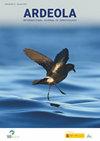Obtaining DNA Samples from Sensitive and Endangered Bird Species: A Comparison of Saliva and Blood Samples
IF 1.2
4区 生物学
Q2 ORNITHOLOGY
引用次数: 2
Abstract
Summary. Methods used to collect biological samples from birds for genetic analyses should allow high-quality DNA to be obtained in sufficient quantities, while limiting negative effects on sampled individuals. In this context, we assessed the potential use of saliva sampling (using buccal swabs) as an alternative to blood sampling (supposedly more stressful) in a near-threatened Caribbean-endemic, the White-crowned Pigeon Patagioenas leucocephala, a bird known to be highly sensitive to capture and handling, based on samples collected from 28 adults captured in the wild. We quantitatively and qualitatively compared DNA extracts, amplifications of two mitochondrial genes (∼430 bp and 1040 bp), and molecular sexing between saliva and blood samples. As expected, blood samples provided larger amounts of DNA of heavy molecular weight than buccal swabs. However, buccal swabs were as reliable as blood samples as a source of genetic material to sequence mtDNA. On the other hand, buccal swab samples might require an improved PCR protocol to sex all individuals successfully. We discuss the use of buccal swabs vs. blood sampling as a way to obtain DNA in relation to research objectives and minimising stress and harmful effects. —Cambrone, C., Motreuil, S., Reyes, F.O., Landestroy, M.A., Cézilly, F. & Bezault, E. (2022). Obtaining DNA samples from sensitive and endangered bird species: a comparison of saliva and blood samples. Ardeola, 69: 263-278. Resumen. Los métodos utilizados para recolectar muestras biológicas de aves para análisis genéticos deberían permitir la obtención de ADN de alta calidad en cantidades suficientes, limitando al mismo tiempo los efectos negativos a los individuos muestreados. En este contexto, evaluamos el uso potencial del muestreo de saliva (usando hisopos bucales) como una alternativa al muestreo de sangre (supuestamente más estresante) en la paloma coronita Patagioenas leucocephala, una especie endémica del Caribe, casi amenazada, y conocida por ser altamente sensible a la captura y manejo. En el estudio se usaron muestras recolectadas de 28 aves adultas capturadas en la naturaleza. Comparamos cuantitativa y cualitativamente extractos de ADN, la amplificación de dos genes mitocondriales (∼430 pb y 1040 pb) y el sexado molecular entre la saliva y la sangre. Como era de esperar, las muestras de sangre produjeron mayores cantidades de ADN y con mayor peso molecular que los hisopos bucales. Sin embargo, los hisopos bucales resultaron ser tan confiables como las muestras de sangre como fuente de material genético para secuenciar el ADNmt. Por otro lado, las muestras de frotis bucales pueden requerir un protocolo de PCR mejorado para sexar a todos los individuos. Discutimos el uso de hisopos bucales frente a la toma de muestras de sangre como una forma de obtener ADN en relación con los objetivos de la investigación y la minimización del estrés y los efectos nocivos.—Cambrone, C., Motreuil, S., Reyes, F.O., Landestroy, M.A., Cézilly, F. y Bezault, E. (2022). Obtención de muestras de ADN de especies de aves sensibles y en peligro: comparación de muestras de saliva y sangre. Ardeola, 69: 263-278.从敏感和濒危鸟类获得DNA样本:唾液和血液样本的比较
总结。用于从鸟类身上采集生物样本进行遗传分析的方法应该能够获得足够数量的高质量DNA,同时限制对样本个体的负面影响。在此背景下,我们基于从野外捕获的28只成年白冠鸽身上采集的样本,评估了唾液取样(使用口腔拭子)作为血液取样(据称压力更大)的替代方法的潜在应用。白冠鸽是一种濒临灭绝的加勒比地区的地方鸟类,已知对捕获和处理高度敏感。我们定量和定性地比较了DNA提取物,两个线粒体基因(~ 430 bp和1040 bp)的扩增,以及唾液和血液样本之间的分子性别。不出所料,血液样本比口腔拭子提供了更多的重分子DNA。然而,作为mtDNA测序的遗传物质来源,口腔拭子和血液样本一样可靠。另一方面,口腔拭子样本可能需要一种改进的PCR方案来成功地对所有个体进行性别鉴定。我们讨论了使用口腔拭子与血液取样作为一种获取DNA的方法,与研究目标和最小化压力和有害影响有关。-Cambrone, C, Motreuil, S, Reyes, f.o., Landestroy, m.a., csamizilly, F. & Bezault, E.(2022)。获取敏感和濒危鸟类的DNA样本:唾液和血液样本的比较。中国生物医学工程学报,26(6):663 - 678。Resumen。3 .通过电子交换器利用电子交换器biológicas .通过电子交换器análisis .通过电子交换器deberían .允许电子交换器obtención .通过电子交换器充分、有限地利用电子交换器、有限地利用电子交换器、有限地利用电子交换器和个人交换器。在这种情况下,评估潜在的唾液病(usando hisopos bucales)和其他的唾液病(supuestamente más estresante),包括冠状瘤、斑马病、斑马病、斑马病,特别是加勒比斑马病、斑马病、斑马病、斑马病、斑马病和斑马病。此外,该工作室还收集了28个成年人在自然环境中捕捉到的照片。比较了ADN的定量和定性提取,la amplificación de dos基因线粒体(~ 430 pb ~ 1040 pb)和el sexado分子中心,唾液和la sangre。Como era de sperar, las muestras de sangre produjeron mayores candades de ADN, conmayor peso molecular que los hisopos bucales。在禁运期间,失去了他的武器装备,造成了他的武器装备和武器装备的损失。穷人,穷人,穷人,穷人,穷人,穷人,穷人,穷人,穷人,穷人,穷人,穷人,穷人,穷人,穷人。讨论了下列问题:1 .从组织的角度出发,从组织的角度出发;2 .从组织的角度出发;3 .从组织的角度出发;3 .从组织的角度出发;3 .从组织的角度出发;2 .从组织的角度出发;-Cambrone, C, Motreuil, S., Reyes, f.o., Landestroy, m.a., csamizilly, F. y Bezault, E.(2022)。Obtención de muestras de ADN de speciies de senbles by en peligro: comparación de muestras de唾液y sangre。中国生物医学工程学报,26(6):663 - 678。
本文章由计算机程序翻译,如有差异,请以英文原文为准。
求助全文
约1分钟内获得全文
求助全文
来源期刊
CiteScore
2.30
自引率
6.20%
发文量
16
审稿时长
>12 weeks
期刊介绍:
Ardeola: International Journal of Ornithology is the scientific journal of SEO/BirdLife, the Spanish Ornithological Society. The journal had a regional focus when it was first published, in 1954. Since then, and particular during the past two decades, the journal has expanded its thematic and geographical scope. It is now a fully international forum for research on all aspects of ornithology. We thus welcome studies within the fields of basic biology, ecology, behaviour, conservation and biogeography, especially those arising from hypothesis-based research. Although we have a long publication history of Mediterranean and Neotropical studies, we accept papers on investigations worldwide.
Each volume of Ardeola has two parts, published annually in January and July. The main body of each issue comprises full-length original articles (Papersand Review articles) and shorter notes on methodology or stimulating findings (Short Communications). The publication language is English, with summaries, figure legends and table captions also in Spanish. Ardeolaalso publishes critical Book Reviewsand PhD-Dissertation Summaries; summarising ornithological theses defended in Spain. Finally there are two Spanish-language sections, Ornithological News; summarising significant recent observations of birds in Spain, and Observations of Rare Birds in Spain, the annual reports of the Spanish Rarities Committee.

 求助内容:
求助内容: 应助结果提醒方式:
应助结果提醒方式:


